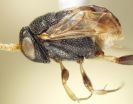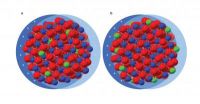(Press-News.org) Researchers discovered several possibly threatened new species of ensign wasps from Sub-Saharan Africa -- the first known insects to exhibit transverse folding of the fore wing. The scientists made this discovery, in part, using a technique they developed that provides broadly accessible anatomy descriptions.
"Ensign wasps are predators of cockroach eggs, and the transverse folding exhibited by these species may enable them to protect their wings while developing inside the cramped environment of cockroach egg cases," said Andy Deans, associate professor of entomology, Penn State. "It also may be useful while they are active in their cockroach prey's leaf-litter environment."
According to Deans, only a few other insects -- mainly some earwigs, cockroaches and beetles -- are capable of folding their hind wings transversely, along a line between the front and back wing margin, as opposed to longitudinal folding, which occurs along a line from the wing base to the wing tip.
"These other insects fold their wings transversely so that the wings can be shortened and tucked under a modified, shell-like fore wing," he said. "This, however, is the first time anyone has observed an insect that folds its fore wings transversely."
The researchers examined wasps belonging to the family Evaniidae from Sub-Saharan Africa. They named five new species -- one of them, Trissevania slideri is named after their colleague David "Slider" Love, coordinator of farm and greenhouse operations, Penn State. The scientists also created an identification key for the new tribe, Trissevaniini.
" We didn't know these new species existed until now, and at least two of them -- Trissevania heatherae and T. mrimaensis -- are found only in a small patch of forest in Kenya that is threatened by mining activity," Deans said.
According to Deans, to officially give a new species a name one must, among other things, provide a diagnosis that describes how this species differs from others.
"In most cases, the diagnosis lists certain phenotypic aspects of the wasps, such as having a black head or fuzzy hind legs," he said. "Diagnoses are typically written in natural language and using one's own custom lexicon. There is no standard syntax to describe the way an organism looks, which makes these data difficult to extract in any large-scale way."
To get around this problem, the researchers developed a technique that provides broadly accessible descriptions.
"The gist is that one could actually query across existing anatomy data using computers," he said. "For example, one could search for all the species that have fuzzy heads, or all the species that have a patch of hairs on the ventral surfaces of their abdomens. One could then cross-reference the result with information about the surrounding environment, the cockroach host, or the evolutionary history of the wasp. The more we test and refine this approach the better we'll understand its capabilities and utility."
In addition to photographing the wasps' wings, the team used principles of origami paper folding to physically visualize the transverse folding of the wings.
"We used origami, one of the most ancient and simple art forms to understand the wing folding, which, based on our observations through microscopes was otherwise impossible to understand," said István Mikó, research associate in entomology. "In our paper, we included a print, cut and fold template for the readers that helps them and us to comprehend the simple, yet enigmatic, wing fold system of the new tribe,"
According to Mikó, insect wings are common subjects of researchers who investigate bio-inspired technologies.
"The relatively simple wing-folding mechanism of the new tribe can be utilized in advance technologies, such as applying morphing systems in aerospace vehicle research or expandable structural systems in space missions," Mikó said.
The team's results appeared in the May 1 issue of PLOS ONE.
The researchers said that by characterizing the phenotypes of these species of wasps, they are one step closer to understanding the evolutionary history of the family Evaniidae.
"Understanding the evolutionary history of this family of wasps is important because this knowledge will inform our attempts to reclassify the wasps in a way that is robust and predictive," Deans said.
In the future, the team plans to use the same methods it developed to investigate other groups of wasps in the family Evaniidae as well as those in the lineage Ceraphronoidea, small wasps that parasitize many other groups of insects and for which very little is known about their diversity and morphology.
INFORMATION:
The National Science Foundation supported this research.
Other authors on the paper include Robert Copeland, consulting scientist and acting head of the Biosystematics Unit, International Centre of Insect Physiology and Ecology; James Balhoff, bioinformatics specialist, University of North Carolina, Chapel Hill; and Matthew Yoder, biological informatician, Illinois Natural History Survey.
Researchers find unique fore wing folding among Sub-Saharan African Ensign wasps
2014-05-02
ELSE PRESS RELEASES FROM THIS DATE:
Probing dopant distribution
2014-05-02
The icing on the cake for semiconductor nanocrystals that provide a non-damped optoelectronic effect may exist as a layer of tin that segregates near the surface.
One method of altering the electrical properties of a semiconductor is by introducing impurities called dopants. A team led by Delia Milliron, a chemist at Berkeley Lab's Molecular Foundry, a U.S Department of Energy (DOE) national nanoscience center, has demonstrated that equally important as the amount of dopant is how the dopant is distributed on the surface and throughout the material. This opens the door ...
Drinking poses greater risk for advanced liver disease in HIV/hep C patients
2014-05-02
PHILADELPHIA—Consumption of alcohol has long been associated with an increased risk of advanced liver fibrosis, but a new study published online in Clinical Infectious Diseases from researchers at Penn Medicine and other institutions shows that association is drastically heightened in people co-infected with both HIV and chronic hepatitis C virus (HCV) infection. Even light ("nonhazardous") drinking—which typically poses a relatively low risk for uninfected persons—was linked to an increased risk of liver fibrosis in the co-infected group.
Reasons for this are not fully ...
Space Station research shows that hardy little space travelers could colonize Mars
2014-05-02
In the movies, humans often fear invaders from Mars. These days, scientists are more concerned about invaders to Mars, in the form of micro-organisms from Earth. Three recent scientific papers examined the risks of interplanetary exchange of organisms using research from the International Space Station. All three, Survival of Rock-Colonizing Organisms After 1.5 Years in Outer Space, Resistance of Bacterial Endospores to Outer Space for Planetary Protection Purposes and Survival of Bacillus pumilus Spores for a Prolonged Period of Time in Real Space Conditions, have appeared ...
Story tips from the Department of Energy's Oak Ridge National Laboratory, May 2014
2014-05-02
To arrange for an interview with a researcher, please contact the Communications staff member identified at the end of each tip. For more information on ORNL and its research and development activities, please refer to one of our media contacts. If you have a general media-related question or comment, you can send it to news@ornl.gov.
DIESELS – Reducing soot . . .
Nine U.S. diesel engine manufacturers and Oak Ridge National Laboratory are using their collective horsepower to tackle the perennial industry-wide problem of efficiency-robbing soot in engines. Over time, ...
Vanderbilt study explores genetics behind Alzheimer's resiliency
2014-05-02
Autopsies have revealed that some individuals develop the cellular changes indicative of Alzheimer's disease without ever showing clinical symptoms in their lifetime.
Vanderbilt University Medical Center memory researchers have discovered a potential genetic variant in these asymptomatic individuals that may make brains more resilient against Alzheimer's.
"Most Alzheimer's research is searching for genes that predict the disease, but we're taking a different approach. We're looking for genes that predict who among those with Alzheimer's pathology will actually show ...
Researchers find way to decrease chemoresistance in ovarian cancer
2014-05-02
ATLANTA--Inhibiting enzymes that cause changes in gene expression could decrease chemotherapy resistance in ovarian cancer patients, researchers at Georgia State University and the University of Georgia say.
Dr. Susanna Greer, associate professor of biology, and research partners at the University of Georgia have identified two enzymes that suppress proteins that are important for regulating cell survival and chemoresistance in ovarian cancer. Their findings are published in the journal, PLOS ONE.
Ovarian cancer is one of the deadliest gynecological cancers, with a ...
A transcription factor called SLUG helps determines type of breast cancer
2014-05-02
Findings and Significance: During breast-tissue development, a transcription factor called SLUG plays a role in regulating stem cell function and determines whether breast cells will mature into luminal or basal cells.
Studying factors, such as SLUG, that regulate stem-cell activity and breast-cell identity are important for understanding how breast tumors arise and develop into different subtypes. Ultimately, this knowledge may help the development of novel therapies targeted to specific breast-tumor subtypes.
Background: Stem cells are immature cells that can differentiate, ...
Key protein, FABP5, enhances memory and learning
2014-05-02
Case Western Reserve researchers have discovered that a protein previously implicated in disease plays such a positive role in learning and memory that it may someday contribute to cures of cognitive impairments. The findings regarding the potential virtues of fatty acid binding protein 5 (FABP5) — usually associated with cancer and psoriasis — appear in the May 2 edition of The Journal of Biological Chemistry.
"Overall, our data show that FABP5 enhances cognitive function and that FABP5 deficiency impairs learning and memory functions in the brain hippocampus region," ...
Better sleep predicts longer survival time for women with advanced breast cancer
2014-05-02
DARIEN, IL – A new study reports that sleep efficiency, a ratio of time asleep to time spent in bed, is predictive of survival time for women with advanced breast cancer.
Results show that higher sleep efficiency was significantly associated with lower mortality over the ensuing six years, an effect that remained after adjusting for baseline prognostic factors such as age, estrogen receptor status and treatments received. Mean survival was 68.9 months for efficient sleepers compared with 33.2 months for participants with poor sleep efficiency. Further analysis found that ...
How bacteria exploit proteins to trigger potentially lethal infections
2014-05-02
New research by scientists at the University of York sheds light on how bacteria exploit human proteins during infections.
A research team led by Professor Jennifer Potts, a British Heart Foundation Senior Research Fellow in York's Department of Biology, studied how Staphylococcus aureus, which can cause life-threatening human infections, attach to two proteins fibronectin and fibrinogen found in human blood.
The human proteins play important roles in clot formation and wound healing and the bacteria appear to exploit them during the process of infection.
Scientists ...



